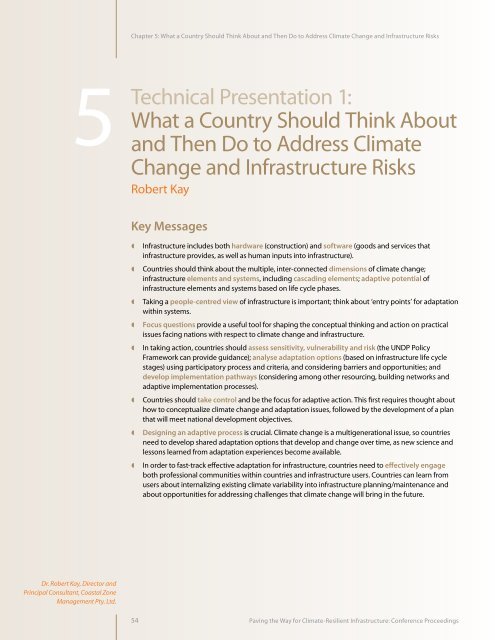Chapter 5: What a Country Should Think About and Then Do to Address <strong>Climate</strong> Change and <strong>Infrastructure</strong> Risks5TechnicalPresentation 1:What a Country Should Think Aboutand Then Do to Address <strong>Climate</strong>Change and <strong>Infrastructure</strong> RisksRobert KayKey Messages<strong>Infrastructure</strong> includes both hardware (construction) and software (goods and services thatinfrastructure provides, as well as human inputs into infrastructure).Countries should think about <strong>the</strong> multiple, inter-connected dimensions of climate change;infrastructure elements and systems, including cascading elements; adaptive potential ofinfrastructure elements and systems based on life cycle phases.Taking a people-centred view of infrastructure is important; think about ‘entry points’ <strong>for</strong> adaptationwithin systems.Focus questions provide a useful tool <strong>for</strong> shaping <strong>the</strong> conceptual thinking and action on practicalissues facing nations with respect to climate change and infrastructure.In taking action, countries should assess sensitivity, vulnerability and risk (<strong>the</strong> <strong>UN</strong>DP PolicyFramework can provide guidance); analyse adaptation options (based on infrastructure life cyclestages) using participatory process and criteria, and considering barriers and opportunities; anddevelop implementation pathways (considering among o<strong>the</strong>r resourcing, building networks andadaptive implementation processes).Countries should take control and be <strong>the</strong> focus <strong>for</strong> adaptive action. This first requires thought abouthow to conceptualize climate change and adaptation issues, followed by <strong>the</strong> development of a planthat will meet national development objectives.Designing an adaptive process is crucial. <strong>Climate</strong> change is a multigenerational issue, so countriesneed to develop shared adaptation options that develop and change over time, as new science andlessons learned from adaptation experiences become available.In order to fast-track effective adaptation <strong>for</strong> infrastructure, countries need to effectively engageboth professional communities within countries and infrastructure users. Countries can learn fromusers about internalizing existing climate variability into infrastructure planning/maintenance andabout opportunities <strong>for</strong> addressing challenges that climate change will bring in <strong>the</strong> future.Dr. Robert Kay, Director andPrincipal Consultant, Coastal ZoneManagement Pty. Ltd.54<strong>Paving</strong> <strong>the</strong> <strong>Way</strong> <strong>for</strong> <strong>Climate</strong>-<strong>Resilient</strong> <strong>Infrastructure</strong>: Conference Proceedings
Chapter 5: What a Country Should Think About and Then Do to Address <strong>Climate</strong> Change and <strong>Infrastructure</strong> RisksPART IIFull PresentationThis video presentation discusses what a country needs to conceptualize and <strong>the</strong>n do to address issuesaround <strong>the</strong> impacts of climate change on infrastructure. The discussion is structured into three sections:(1) a brief introduction; (2) <strong>the</strong> issues that countries need to think about (conceptual issues); and (3) actionsthat countries need to take (action-oriented considerations).Introduction: Defining and adapting infrastructureDefinitions of infrastructure include both hardware (i.e. construction, such as roads, bridges, airports, andbuildings) and software, including inputs, components of what goes into <strong>the</strong> development of infrastructure(i.e. people involved in designing, building and retrofitting infrastructure), and outputs, componentsof what infrastructure provides <strong>the</strong> community. According to <strong>the</strong> Organisation <strong>for</strong> Economic Co-operationand Development (OECD), infrastructure is not an end in itself but a means <strong>for</strong> providing goods and servicesto society <strong>for</strong> achieving development goals (i.e. Millennium Development Goals, general economic prosperityand social well-being) (2007). These ‘soft’ elements of infrastructure are based on a people-orientedview of infrastructure and climate change risk.Adapting infrastructure to climate change impacts is imperative. The Intergovernmetal Panel on <strong>Climate</strong>Change’s Fourth Assessment Report and more recent scientific work clearly show <strong>the</strong> inevitable consequencesof climate change due to past and present greenhouse gas (GHG) emissions. However, climatechange does not affect <strong>the</strong> basic principles of infrastructure provision <strong>for</strong> development, economic growthand environmental sustainability. <strong>Climate</strong> change is only one of many development challenges. Thus,thinking about climate change impacts on infrastructure, requires consideration of <strong>the</strong> overall developmentcontext (national, local and community development objectives).There are various conceptual challenges and practical difficulties in adaptation with respect to infrastructure.Firstly, countries need a clear conceptual understanding of climate change and adaptation, specificallyin terms of infrastructure. Secondly, countries must address <strong>the</strong> practical challenges of implementingadaptation as it relates to infrastructure, including significant uncertainties and methodological challengesrelated to risk assessment, adaptation options, implementation and measures of effectiveness.However, <strong>the</strong>se challenges should not be a constraint to pursuing adaptation action.What countries should considerIn order to better conceptualize climate change and infrastructure risks, countries should consider <strong>the</strong>following concepts:1. Cross-cutting climate change dimensions;2. <strong>Infrastructure</strong> elements and systems;3. Adaptive potential of infrastructure elements and systems; and4. People-centered view (consider who is developing and using infrastructure).Applying a series of focus questions helps guide thinking about <strong>the</strong>se four different components. Elevenfocus questions are provided in <strong>the</strong> Resource Guide supporting <strong>the</strong> presentation.TechnicalPresentation 1What a Country ShouldThink About andThen Do to Address<strong>Climate</strong> Change and<strong>Infrastructure</strong> RisksTechnicalPresentation 2Internalization of<strong>Climate</strong> Risks in <strong>the</strong>Context of Planningand Urban DevelopmentTechnicalPresentation 3A Framework <strong>for</strong>Risk Assessmentand Risk-In<strong>for</strong>medDecision-Making <strong>for</strong><strong>Infrastructure</strong>DevelopmentTechnicalPresentation 4Probabilistic RiskModeling: BasicPrinciples andApplicationsTechnicalPresentation 5An Economic Framework<strong>for</strong> Evaluating <strong>Climate</strong>Proofing Investmentson <strong>Infrastructure</strong>TechnicalPresentation 6Supporting ElSalvador to Reduce<strong>Infrastructure</strong> Riskswithin a Green, Low-Emission and <strong>Climate</strong>-<strong>Resilient</strong> Framework<strong>for</strong> Development<strong>Paving</strong> <strong>the</strong> <strong>Way</strong> <strong>for</strong> <strong>Climate</strong>-<strong>Resilient</strong> <strong>Infrastructure</strong>: Conference Proceedings 55
















